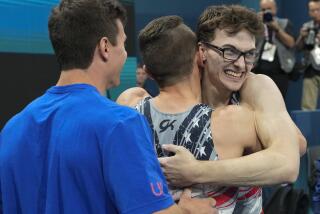Horsemanship for Handicapped : Class Gives Disabled a Spur to Confidence
- Share via
From her electronic wheelchair, Kati Bristol stretched her left arm to stroke Jessie, a 7-year-old brown mare.
“Jessie wants to know why you don’t use your other hand,” said Melinda Miller, who owns the horse and held its reins at an equestrian center in West Covina run by Ridge Riders Inc.
Jessie nuzzled against the smiling Kati, 9, who has cerebral palsy and suffers more spastic paralysis on her right side than her left. Miller, a physical therapist who volunteers her time in this special horsemanship class for the handicapped, said later she was trying to encourage Kati to use her right hand.
“I knew why she didn’t but I wanted her to think about it,” Miller said.
Officials are hoping that through the class, which was offered by Mt. San Antonio College for the first time this summer, the students will gain not only knowledge about horses, but also confidence that they can do some of the things people without handicaps can do.
Learning by Determination
“Those who sit in a wheelchair will learn, even if they have to pull themselves from the mane of horse to do it,” said Pat Morris, who teaches the class with the aid of volunteers like Miller.
“We try to conduct the class and do it just exactly as a regular class,” Morris said. “One of our goals is to teach them how to ride like a regular person. In some cases this happens. In some cases this never happens.”
Therapists told Kati’s mother not to expect too much for her daughter. “But lately, the therapists have said, ‘Just don’t say no,’ because they’re learning she has so much determination,” Nancy Bristol said, grinning as she watched her daughter rock back and forth on Jessie, with volunteers on both sides for protection.
It takes five people to lift Bob Rondinella onto a horse. On one side, three people lift his legs and body onto the animal, and on the other side, two adjust him.
Rondinella, 28, also suffers from cerebral palsy. He has ridden horses before while on vacation, his mother Carolyn Rondinella said, and it helped to loosen the muscles in his legs.
“I’ve always been fascinated with horses,” said Rondinella, his speech strained. “They’re fun.”
The idea for a college course teaching the handicapped how to ride was proposed by the members of Ridge Riders, a riding club. Started this summer as an experiment, the free course proved so successful that it is being offered again this fall by Mt. San Antonio.
Waiting List
All 11 spots in the fall course are filled, and there is a waiting list for the spring course. The students range in age from 3 to 55.
Although teaching the handicapped to ride as therapy is not a new idea, Yvonne Hillmann, a member of Ridge Riders, said it is the first time such a class has been offered in this area, adding that the class has drawn people from as far away as Long Beach and San Bernardino.
Most of the courses Mt. San Antonio offers for handicapped students are designed to help them get into the workplace. College officials say the riding class falls under the school’s function as a provider of community education.
“Handicapped people are in the community. They are also taxpayers,” said Edward Hernandez Jr., dean of community services for the college. “They have a right to educational opportunities.”
The riding class is the only course that Morris, a retired nurse who has run stables and been involved with horses for 25 years, teaches at the college.
Morris, who has taught horsemanship to the handicapped at private stables for 10 years, said she hopes her students will learn about themselves as they master the art of horsemanship.
“It’s pretty nice for people who have to sit in wheelchairs to sit on top of a horse and be able to look down instead of always having someone look down on them,” she said.
Sylvia Seyler said she feels a sense of power with “just the idea of knowing that I can control a 1,600-pound animal.”
Seyler, who suffers from multiple sclerosis, said she owned and rode horses before the disease confined her to a wheelchair six years ago.
She began riding with Morris about two years ago. At the time, she could not bring her knees together. But in her motorized wheelchair, she demonstrated that she now can clasp her knees with little effort.
The parents of another student, Theresa Chase, said that their daughter has gained confidence from the class. Theresa, 16, who suffers from cerebral palsy and has ridden horses for five years, also has overcome her fear of height, crowds and open spaces.
“We use horses more or less as medicine,” said Theresa’s mother, Marie Chase. “The idea that she’s going to ride a horse makes her happy.
“In the world, she’s told there’s so many things she can’t do. She’s so proud of herself that she can do what other people can do,” Marie Chase said.






